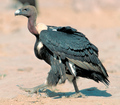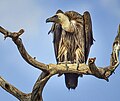
A vulture is a bird of prey that scavenges on carrion. There are 23 extant species of vulture. Old World vultures include 16 living species native to Europe, Africa, and Asia; New World vultures are restricted to North and South America and consist of seven identified species, all belonging to the Cathartidae family. A particular characteristic of many vultures is a bald, unfeathered head. This bare skin is thought to keep the head clean when feeding, and also plays an important role in thermoregulation.
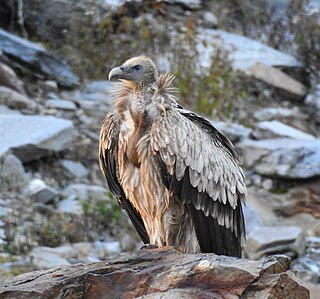
The Himalayan vulture or Himalayan griffon vulture is an Old World vulture native to the Himalayas and the adjoining Tibetan Plateau. It is one of the two largest Old World vultures and true raptors. It is listed as Near Threatened on the IUCN Red List. It is not to be confused with the Eurasian griffon vulture, which is a similar and sympatric species.

The white-rumped vulture is an Old World vulture native to South and Southeast Asia. It has been listed as Critically Endangered on the IUCN Red List since 2000, as the population severely declined. White-rumped vultures die of kidney failure caused by diclofenac poisoning. In the 1980s, the global population was estimated at several million individuals, and it was thought to be "the most abundant large bird of prey in the world". As of 2021, the global population was estimated at less than 6,000 mature individuals.
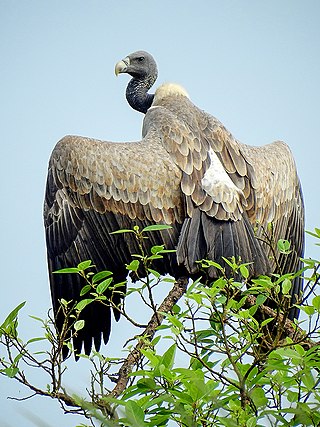
The Indian vulture or long-billed vulture is a bird of prey native to the Indian subcontinent. It is an Old World vulture belonging to the family of Accipitridae. It is a medium-sized vulture with a small, semi-bald head with little feathers, long beak, and wide dark colored wings. It breeds mainly on small cliffs and hilly crags in central India and south India.

The hooded vulture is an Old World vulture in the order Accipitriformes, which also includes eagles, kites, buzzards and hawks. It is the only member of the genus Necrosyrtes, which is sister to the larger Gyps genus, both of which are a part of the Aegypiinae subfamily of Old World vultures. It is native to sub-Saharan Africa, where it has a widespread distribution with populations in southern, East and West Africa. It is a scruffy-looking, small vulture with dark brown plumage, a long thin bill, bare crown, face and fore-neck, and a downy nape and hind-neck. Its face is usually a light red colour. It typically scavenges on carcasses of wildlife and domestic animals. Although it remains a common species with a stable population in the lower region of Casamance, some areas of The Gambia, and Guinea-Bissau, other regions such as Dakar, Senegal, show more than 85% losses in population over the last 50 years. Threats include poisoning, hunting, loss of habitat and collisions with electricity infrastructure, and the International Union for Conservation of Nature has rated its conservation status as "critically endangered" in their latest assessment (2022). The highest current regional density of hooded vultures is in the western region of The Gambia.
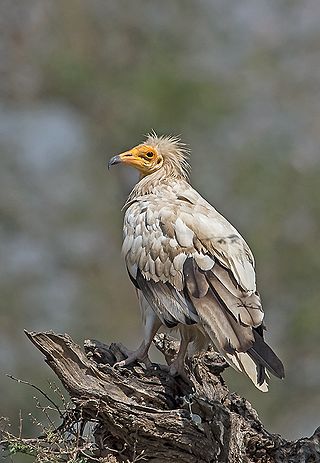
The Egyptian vulture, also called the white scavenger vulture or pharaoh's chicken, is a small Old World vulture in the monotypic genus Neophron. It is widely distributed from the Iberian Peninsula, North Africa, West Asia and India. The contrasting underwing pattern and wedge-shaped tail make it distinctive in flight as it soars in thermals during the warmer parts of the day. Egyptian vultures feed mainly on carrion but are opportunistic and will prey on small mammals, birds, and reptiles. They also feed on the eggs of other birds, breaking larger ones by tossing a large pebble onto them.

The white-backed vulture is an Old World vulture in the family Accipitridae, which also includes eagles, kites, buzzards and hawks. It is the most common vulture species in the continent of Africa.

The cinereous vulture is a large raptor in the family Accipitridae and distributed through much of temperate Eurasia. It is also known as the black vulture, monk vulture and Eurasian black vulture. With a body length of 1.2 m, 3.1 m (10 ft) across the wings and a maximum weight of 14 kg (31 lb), it is the largest Old World vulture and largest member of the Accipitridae family.

Rüppell's vulture, also called Rüppell's griffon vulture, named after Eduard Rüppell, is a large bird of prey, mainly native to the Sahel region and East Africa. The former population of 22,000 has been decreasing due to loss of habitat, incidental poisoning, and other factors. Known also as Rüppell's griffon, Rueppell's griffon, Rüppell's griffin vulture, Rueppell's vulture and other variants, it is not to be confused with a different species, the griffon vulture. Rüppell's vulture is considered to be the highest-flying bird, with confirmed evidence of a flight at an altitude of 11,300 m (37,000 ft) above sea level.

Aegypiinae is one of two subfamilies of Accipitridae that are referred to as Old World vultures, the other being the Gypaetinae. They are not closely related to the Gypaetinae, and are instead a sister group to the serpent-eagles (Circaetinae).

Scavengers are animals that consume dead organisms that have died from causes other than predation or have been killed by other predators. While scavenging generally refers to carnivores feeding on carrion, it is also a herbivorous feeding behavior. Scavengers play an important role in the ecosystem by consuming dead animal and plant material. Decomposers and detritivores complete this process, by consuming the remains left by scavengers.

The Cape vulture, also known as Cape griffon and Kolbe's vulture, is an Old World vulture in the family Accipitridae. It is endemic to southern Africa, and lives mainly in South Africa, Lesotho, Botswana, and in some parts of northern Namibia. It nests on cliffs and lays one egg per year. In 2015, it had been classified as Endangered on the IUCN Red List, but was down-listed to Vulnerable in 2021 as some populations increased and have been stable since about 2016.

The red-headed vulture, also known as the Asian king vulture, Indian black vulture or Pondicherry vulture, is an Old World vulture mainly found in the Indian subcontinent, with small disjunct populations in some parts of Southeast Asia.
Visceral gout is a disease of birds in which kidney failure causes a build-up of urates in the internal organs, leaving a chalky white coating on them. Symptoms include anorexia and emaciation.

The white-headed vulture is an Old World vulture endemic to Africa. Populations have been declining steeply in recent years due to habitat degradation and poisoning of vultures at carcasses. An extinct relative was also present in the Indonesian island of Flores during the Late Pleistocene, indicating that the genus was more widespread in the past.

The Gypaetinae is one of two subfamilies of Old World vultures the other being the Aegypiinae. Some taxonomic authorities place the Gypaetinae within the Perninae hawks. They are presently found throughout much of Africa, Asia, and southern Europe, hence being considered "Old World" vultures, but as recently as the Late Pleistocene, they were also present in North America.

Nine species of vulture can be found living in India, but most are now in danger of extinction after a rapid and major population collapse in recent decades. In the early 1980s, three species of Gyps vultures had a combined estimated population of 40 million in South Asia, while in 2017 the total population numbered only 19,000.
A vulture restaurant is a site where carrion, decaying flesh from dead animals, is deposited in order to be consumed by vultures, and is sometimes referred to more generally as supplemental feeding or provisioning. These stations can also be referred to as vulture feeding sites, vulture feeding stations, and vulture safe zones. This supplemental feeding practice is used to provide vultures with reliable, non-contaminated food sources or to aid in monitoring schemes. Vulture restaurants have been instituted as a method of vulture conservation in Europe and Africa since the 1960's and 70's, when vulture populations began to decline. This strategy is used because often population declines are attributed to low food availability, food contamination or insufficient nutritional quality, or feeding from human areas leading to conflict. Notably, large vulture population declines in South Asia, referred to as the Asian or Indian vulture crisis, and Africa, referred to as the African vulture crisis, have brought renewed attention to the uses and impacts of vulture restaurants. Vulture restaurants are used in Asia, Africa, Europe, and North America for various conservation and management plans. They can help combat food-derived threats to vultures, such as diclofenac or lead contamination or conflict with ranchers and poachers. The first vulture restaurant was built in South Africa in 1966. Vulture restaurants operate in a number of countries, including Nepal, India, Cambodia, South Africa, Eswatini, and Spain.

The African vulture trade involves the poaching, trafficking, and illegal sale of vultures and vulture parts for bushmeat and for ritual and religious use, like traditional medicines, in Sub-Saharan Africa. This illegal trade of vultures and vulture parts is contributing to a population crisis on the continent. In 2017, the IUCN Red List categorized 7 of Africa's 11 vulture species as globally endangered or critically endangered. Recent research suggests that 90% of vulture species declines in Africa may be due to a combination of poisoning and illegal wildlife trade for medicinal use and/or bushmeat. All trade of African vultures is illegal, as these birds are protected by international laws.
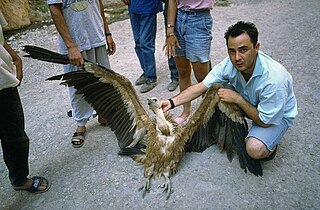
The African vulture crisis is the name given to the ongoing population decline in several Old World vulture species across Africa. Steep population declines have been reported from many locations across the continent since the early 2000s. The causes are mainly poisoning from baited animal carcasses, and the illegal trade in vulture body parts for traditional medicine. Available data suggest that the African vulture crisis may be similar in scale to the Indian vulture crisis, but more protracted and less well documented.








